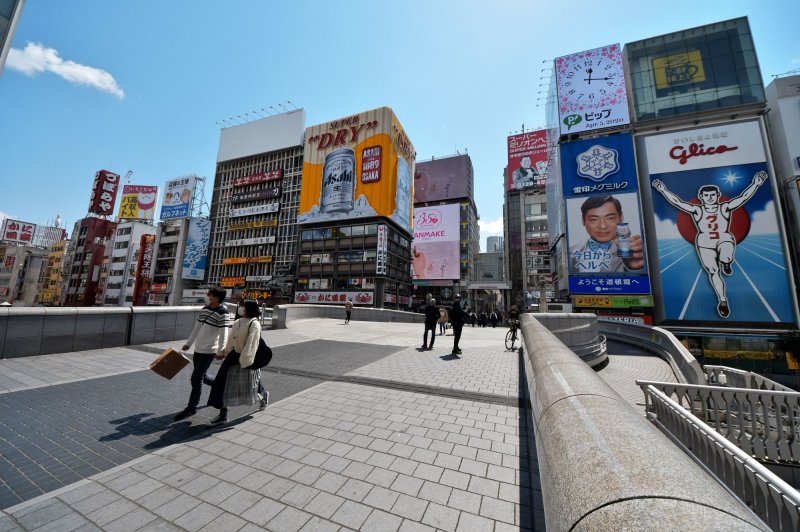New technology turns plastic trash into jet fuel

Plastic waste could one day be repurposed into jet fuel, according to a process outlined in a study published on Monday. Photo bayy LeeRosario/Pixab
May 17 (UPI) -- Researchers at Washington State University have developed a new method for converting plastic waste into jet fuel.
The technique, detailed Monday in the journal Chem Catalyst, can be tweaked to turn plastic waste into a variety of in-demand hydrocarbon products.
Importantly, the conversion method is highly efficient, working at moderate temperatures and converting nearly 90 percent of the input material.
The technique is also fast, taking less than an hour from start to finish.
"In the recycling industry, the cost of recycling is key," lead researcher Hongfei Lin said in a news release.
"This work is a mile stone for us to advance this new technology to commercialization," said Lin, an associate professor of chemical engineering at the Washington State University.
The accumulation of plastics in ecosystems across the globe remains one of the planet's most pressing environmental problems.
As larger pieces of plastic trash -- like bags, bottles and synthetic clothing -- get broken down, these tiny pieces of plastic, or microplastics, can filter into bodies of water or get blown into the atmosphere and deposited in faraway places.
Research suggests tiny bits of plastic are being consumed by coral and mollusks, and are even being ingested by deep sea creatures living a few thousand feet below the ocean surface.
When plastic is discarded instead of recycled, it doubly harms the environment.
RELATED Plastic particles proliferate globally, spread by ocean waves and through the air
In addition to causing direct ecological harm, the discarded plastic ensures new plastic must be generated to meet commercial demands -- and plastic production remains a carbon intensive process.
Converting plastic waste into usable products can help shrink the plastic industry's carbon footprint.
Typically, recycled plastic is simply melted and remolded, but the recycling process reduces the plastic's quality and structural integrity.
Plastic waste can also be converted into usable chemicals, but conversion methods are currently too expensive and energy intensive. As a result, just 9 percent of plastic waste is recycled in the United States.
In the lab, scientists deployed a ruthenium on carbon catalyst and a common solvent to trigger the depolymerization process and turn plastic waste into the components used to make jet fuel.
The conversion technique worked at temperatures of approximately 428 degrees Fahrenheit, much lower than temperatures used for other conversion methods.
"Before the experiment, we only speculated but didn't know if it would work," Lin said. "The result was so good."
Researchers showed that by tweaking the conversion time and temperature, or the amount of catalyst used, they were able to fine-tune the process to yield desirable plastic-derived materials.
"Depending on the market, they can tune to what product they want to generate," Lin said. "They have flexibility. The application of this efficient process may provide a promising approach for selectively producing high-value products from waste polyethylene."
upi.com/7096720
Microbes could help remove microplastics from the environment
While larger plastics can, theoretically, be easily collected and disposed of, the bits they leave behind, called microplastics, are much harder to get out of the environment -- but researchers say biofilms could help to do it. File Photo by Jennifer Lavers/IMAS/EPA
April 28 (UPI) -- Researchers in Hong Kong have developed a new way to remove microplastics from the environment.
Their method uses biofilms, large mats of microorganisms, to trap microplastics, which can then be collected for processing and recycling.
On Wednesday, researchers presented the new technique to virtual attendees of the Microbiology Society's Annual Conference.
In the lab, scientists cultivated mats of Pseudomonas aeruginosa, a bacteria species known to colonize microplastics. The bacteria species is quite common and adapted to a variety of environments.
When the biofilms colonized microplastics inside a bioreactor, researchers noted the tiny bits of plastics accumulate to form larger aggregates and sank to the bottom of the microbial mat.
"[This] allows convenient release of microplastics from the biofilm matrix, which is otherwise difficult and expensive to degrade, so that the microplastics can be later recovered for recycling," lead researcher Yang Liu, scientist at Hong Kong Polytechnic University, said in a news release.
The initial lab experiments showed that the microbial mat works as expected, but now scientists want to see if their method can perform in real world settings.
"We next plan to isolate and identify natural pro-biofilm forming bacterial isolates either from the sewage or from aquatic environments, where they display heightened abilities to colonize and form biofilms on microplastics," Liu said.
Eventually, researchers hope their technology can be deployed in wastewater treatment plants where it microplastics can be captured before they're carried into the ocean.
Previous surveys have found microplastic pollutant in a diversity of ecosystems.
Research suggests tiny bits of plastic are being consumed by coral and mollusks, and are even being ingested by deep sea creatures living a few thousand feet below the ocean surface.
Microplastics are formed from a variety of materials, including bags, bottles and synthetic clothing. When these larger items end up in the environment, they get broken down over time, releasing tiny bits of plastic into the environment.
Over time, many of these plastic particles filter into bodies of water. Some get blown into the atmosphere and deposited in faraway places, including mountain peaks and polar glaciers.
Biofilms are often the enemy of scientists and health professionals as the woven layers of microbes can protect harmful bacteria from antibiotics and other treatments.
But Liu and company hope their research will inspire other scientists to think about the potential advantages of biofilms for environmental cleanups and other applications.
"It is imperative to develop effective solutions that trap, collect, and even recycle these microplastics to stop the 'plastification' of our natural environments," Liu said.
New 'biodegradable' plastics actually
degrade

Plastic modified by researchers, (L), breaks down after just three days in standard compost, (R), and breaks down entirely after two weeks, suggesting the new substance could be preferable to other plastics that biodegrade partially or not at all. Photo by Christopher DelRe/UC Berkeley
April 21 (UPI) -- Most plastics advertised as "biodegradable" aren't all that degradable. In fact, researchers estimate that most of these supposedly eco-friendly plastics end up in landfills and last just as long as forever plastics.
Scientists at the University of California, Berkeley, have developed a new method for composting biodegradable plastics -- one that actually works
Most compostable plastics are composed of a kind of polyester called polylactic acid, or PLA. In the lab, researchers deployed a combination of heat and water to degrade PLA plastics in record time.
The composting breakthrough, described Wednesday in the journal Nature, was enabled by the addition of polyester-eating enzymes during the plastic production process.
RELATED Scientists turn fish parts into environmentally friendly plastic
When exposed to heat and water, the enzymes free themselves from the surrounding polymer chains and begin munching away on PLA molecules. The enzymes turn the PLA into lactic acid, which is consumed by various microbes in the soil.
Other plastic degradation processes yield tiny plastic particles called microplastics. In recent years, surveys have found microplastic pollution in the organs of humans and animals, as well in some of the planet's most remote ecosystems.
The new composting method turns 98 percent of the PLA into simple molecules.
RELATED Products made from hemp-based plastics enter consumer market
The novel technology, which scientists have recently spun off into a start-up company, is years in the making.
One of the key innovations came in 2018, when researchers developed synthetic molecules called random heteropolymers, or RHPs, used to enwrap the plastic-eating enzymes and prevent them from falling apart during the plastic production process.
For the new study, researchers mixed thousands of these enzyme-enshrining RHPs with the plastic resin beads that jumpstart the plastic production process. Scientists liken the process to the addition of pigments to make colored plastics.
RELATED Spider silk, wood combination replicates material advantages of plastic
"If you have the enzyme only on the surface of the plastic, it would just etch down very slowly," co-author Ting Xu, professor of materials science and chemical engineering at Berkeley, said in a press release.
"You want it distributed nanoscopically everywhere so that, essentially, each of them just needs to eat away their polymer neighbors, and then the whole material disintegrates," Xu said.
Tests showed the addition of the nanoparticles did not impact the functionality of the plastic. The PLA material could still be melted and reformed into a variety of products, including extruded fibers.
In the lab, scientists degraded PLA fibers using different combinations of heat and water. At room temperature, 80 percent of the fibers degraded within a week. At 122 degrees Fahrenheit, all of the fibers degraded within six days.
Researchers suggest the plastics could be composted at municipal sites or at home.
"It turns out that composting is not enough -- people want to compost in their home without getting their hands dirty, they want to compost in water," Xu said.
"So, that is what we tried to see. We used warm tap water. Just warm it up to the right temperature, then put it in, and we see in a few days it disappears," she said.
Xu and her colleagues said they are now working on developing other types of enzyme nanoparticles than can be used to degrade other kinds of polyester materials.
Scientists in Japan develop decomposable plastic

Scientists in Osaka, Japan, say they have developed a new plastic that disintegrates at sea. File Photo by Keizo Mori/UPI | License Photo
April 7 (UPI) -- Japanese scientists say they have developed plastic that can disintegrate at sea within 30 days.
The Asahi Shimbun reported the plastic contains cassava, a raw material used to make tapioca, and cellulose found in wood pulp, originating from tropical climates.
The new material is the result of collaboration between an Osaka University-led engineering team and Japan Food Research Laboratories, according to the report.
The plant material is not expensive to make, scientists say. The starch and cellulose were dissolved in water, rolled out into a thin layer, and then turned into a transparent sheet after applying heat.
RELATED Scientists discover plastic-eating microbe
"We would first like to use it as food packaging materials, which are very familiar to people and are often contained in the waste in the sea," said Hiroshi Uyama, a professor of engineering at Osaka University. "I hope that this will be a part of the solution to the issue and raise the interest of people."
Japanese scientists also said the sheet, which measures about 100 micrometers in thickness, has twice the strength of plastics composed of polyethylene.
Marine microorganisms are key to decomposing the new plastic. When placed in seawater filled with microorganisms, the sheet had been torn apart in 30 days; the sheet was not destroyed in water with fewer microorganisms, however.
RELATED Researchers find new way to predict where ocean trash, seaweed will go
Regular plastic bags take about 20 years to decompose after being discarded into the ocean, and plastic bottles take as much as 450 years. About 8 million tons of plastic waste is thrown into the sea annually. The World Economic Forum has said micro-plastics would outweigh fish in oceans across the globe by 2050.
Japan is the second-biggest emitter of plastic waste per capita after the United States, according to The Guardian.
The country used to send 1.5 million tons of plastic waste to China annually, until Beijing banned waste imports in 2017.
Scientists turn plastic into moisture-
wicking textile

MIT engineers developed self-cooling fabrics from polyethylene, commonly used in plastic bags, that they say may be more sustainable than cotton and other common textiles. Photo by Svetlana Boriskina/MIT
March 15 (UPI) -- Scientists have developed a new strategy for turning plastic into wearable textiles. The breakthrough -- described Monday in the journal Nature Sustainability -- could help ease Earth's growing plastic pollution problem.
Attempts to make plastic textiles have previously faltered as a result of polyethylene's inability to wick away and evaporate moisture.
However, engineers at MIT have managed to weave polyethylene into fibers that absorb and evaporate water more quickly than cotton, nylon, polyester and other common textiles.
The authors of the new paper hope their technology will incentivize plastic recycling.
RELATED New radiation vest technology protects astronauts, doctors
"Once someone throws a plastic bag in the ocean, that's a problem," Svetlana Boriskina, mechanical engineer at MIT, told MIT News.
"But those bags could easily be recycled, and if you can make polyethylene into a sneaker or a hoodie, it would make economic sense to pick up these bags and recycle them," Boriskina said.
More than just a plastic pollution solution, researchers suggest plastic textiles could be more eco-friendly over the course of their life cycle than cotton and nylon textiles.
RELATED Scientists in Japan develop decomposable plastic
Polyethylene is the world's most common plastic. Its carbon-hydrogen molecules form Teflon-like chains that resist binding with water and other molecules.
"Everyone we talked to said polyethylene might keep you cool, but it wouldn't absorb water and sweat because it rejects water, and because of this, it wouldn't work as a textile," Boriskina said.
Researchers tried anyways, using standard textile manufacturing to turn polyethylene powder into thin fibers.
RELATED Plastic found in amphipods in Earth's deepest ocean trench
Scientists were surprised to find the fiber-fabrication process caused the polyethylene to become weakly hydrophilic -- attracting, not repelling, water molecules.
To create wearable textiles, researchers fed their fibers back into the extrude, fusing multiple fibers into threads that could woven together. The fused fibers yielded capillaries capable of absorbing and trapping moisture attracted to the thread's surface.
Both computer models and tweaks to the production process showed the thread's wicking abilities could be improved by altering its diameter and the arrangement of its fibers.
Though the material's wicking ability decreased after getting wet multiple times, scientists found that its wicking properties could be refreshed by both friction and UV light.
"You can refresh the material by rubbing it against itself, and that way it maintains its wicking ability," Boriskina said. "It can continuously and passively pump away moisture."
Researchers were able to color the threads by mixing colored particles with the polyethylene powder prior to the extrusion process. Authors of the new paper suggest the process is more eco-friendly than traditional textile dyeing processes.
Though the polyethylene fibers weakly attract and absorb water, they still don't bind with other molecules, which make them easier to clean -- saving energy that would be otherwise used to power longer, warmer wash cycles.
"It doesn't get dirty because nothing sticks to it," Boriskina said. "You could wash polyethyelene on the cold cycle for 10 minutes, versus washing cotton on the hot cycle for an hour."
Even if polyethylene textiles relied on newly produced plastic, scientists estimate the plastic-derived material would still be more eco-friendly than traditional textiles.
"Polyethylene has a lower melting temperature so you don't have to heat it up as much as other synthetic polymer materials to make yarn, for example," Boriskina said.
"Synthesis of raw polyethylene also releases less greenhouse gas and waste heat than synthesis of more conventional textile materials such as polyester or nylon. Cotton also takes a lot of land, fertilizer, and water to grow, and is treated with harsh chemicals, which all comes with a huge ecological footprint," Boriskina said.



















